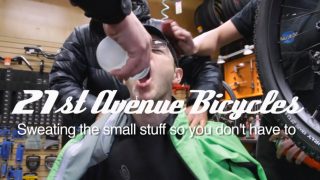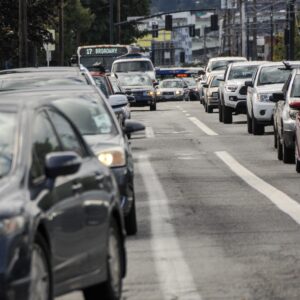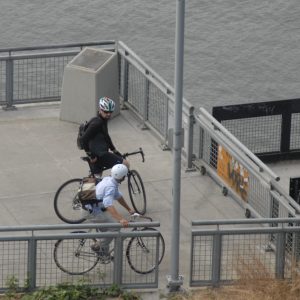Yes I’m very biased, but I honestly think Portland has the most creative and interesting bike shop owners in the country.
I mean, seriously: We’ve got a bike shop that runs out of a converted yellow school bus (that’s been painted purple); a shop that actually promotes other bike shops and will issue you a library card to checkout saddles before you buy one; a shop that was the first in America to import dutch cargo bikes (thus sparking a nationwide craze); a shop that has created a following for their brilliant newspaper ads, and a shop that has become famous worldwide for its unique blend of welcoming attitude, bar offerings, and bike collection. And I could go on and on.
And now the trend continues thanks to two shops who have mastered video marketing: 21st Avenue Bicycles and Well Tuned Fast (WTF) Bikes.
First up, we have 21st Avenue Bicycles. We love this shop. Not only are they a sponsor of my adventure riding habit, but they always seem to having fun whether they’re working or riding. Their recent creative advertising ploy has to do with streetcar tracks — a familiar nemesis to riders everywhere and something they face often due to their northwest Portland location. Once they’d had enough of the crashes and carnage, they set out in the name of science to do something about it. Check out their new video:
Streetcar Track Science from 21st Avenue Bicycles on Vimeo.
Advertisement
And then we’ve got Mr. Tom Daly from WTF Bikes. I follow him on social media and his “WTF Pro Tip!” Vines always make me laugh. They’re short and to the point and delivered in a brutally honest and funny way. Tom uploads several a week. Here are a few of my favorites (they loop automatically, just click each one for sound):
We love our shops here in Portland. Especially the ones who keep things fun.
— Jonathan Maus, (503) 706-8804 – jonathan@bikeportland.org
BikePortland can’t survive without paid subscribers. Please sign up today.







Thanks for reading.
BikePortland has served this community with independent community journalism since 2005. We rely on subscriptions from readers like you to survive. Your financial support is vital in keeping this valuable resource alive and well.
Please subscribe today to strengthen and expand our work.
The train track video is excellent!
But, um, what IS the needed tire size?
Agree. They showed a 45mm sitting in the track, so presumably wider than that.
I notice a huge difference between my 20/23mm tire-equipped-bike and my ~30mm tire-equipped-bike. I think the real trick is it allows crossing at more angles.
Also the biker brought her bike in and left with tires. Where’d the bike go?!
Aha- there’s a blog entry on 21st Ave, linked on the Vimeo page: http://www.21stbikes.com/news/1522016getting-to-the-bottom-of-street-car-track-crossing
“Jan [Heine] has covered the topic numerous times. He finds that 42 mm tires are about ideal for crossing tracks (and urban cycling in general), but they can still get stuck… the 45 mm Fat Boys could actually be wriggled into [the track gap, which is measured at 40mm]…. While the tire is listed as 45 mm, it measures out to 43 on the stock AWOL wheels – looks like our friend Jan Heine’s 42 mm ‘sweet spot’ theory holds up!”
Jan Heine owns Compass Bicycles and publishes Bicycle Quarterly; he’s done the testing on effectiveness of tread, rolling speed (he promotes “wider is faster”), smaller/flexible top tubes to let a bike “plane”, etc.
Jan Heine’s rolling tests are biased in that he rarely tests decent skinny clinchers (and when he does they do well).
4″ Wide.
I can definitely confirm your praise for 21st Ave Bikes! They were my go-to bike shop when I lived in Goose Hollow and they always provided great service.
Sadly, the streetcar track video is just a few days too late for my coworker, who crashed this past Monday. On his new bike. On his first day biking to work since moving to Portland in December. Wah wah.
21st is great. Legit mechanics, and honest. They have my business.
Just to add a (possibly unwelcome) perspective on streetcar tracks. If any readers have spent any time cycling in the acknowledged best places for city cycling in the world (Netherlands, Denmark etc) they’ll note streets well more crisscrossed with tracks than we here… by far. Given density of both rail and cycle routes, overlap and intersection are inevitable. Why is this not a problem for them? While one does see the occasional cyclist clatter to the ground there; they’re virtually all tourists (often US or UK) unused to city cycling. It’s a rare day a local will have a mishap; they’ve been riding the terrain since infancy and know without a thought to cross tracks at a steep enough angle to prevent tire drop. It may sound like blaming the victim, but part of pretty much any great cycling city is a great rail transit system. (not a coincidence) Given how foreign this is to US Car Culture it’s no wonder cyclists here don’t get it. But perhaps they should. Motorists after all learn 1001 unspoken, unwritten ways to negotiate conditions and frankly this is assumed knowledge if you’re going to drive effectively. You don’t even think about them; they’re innate. Maybe the same for cycling? I’ve seen little groups of Amsterdammers cluster around cycling tourists fallen at tracks. They’re polite, concerned and ready to offer help. But there’s also a vibe of incredulity that someone would blunder this way. They can’t understand how one wouldn’t know to navigate around tracks. They don’t understand because it’s all they known since being children, not seeing how it is for us in essentially bikeless environments with citizens too inexperienced to function as city cyclists.
OK, let the slings and arrows pour in 😉
No arrows here but when I spent time in the Netherlands I did not find many of these areas at all. In fact, often the track crossings were perpendicular or there was a cycletrack nearby. The Dutch also ride much different bikes where most of the weight is on the rear tire vs in the US a lot of the bikes are designed so you’re in more of a forward leaning position.
Yes, education is a valuable tool in preventing crashes, as is building infrastructure that avoids most of these conflicts in the first place. In Portland we can do this, but we’ll have to get rid of some parking to do so.
If folks choose to go by bike they should learn how to operate one. This idea that I live in some awful, crowded, too many people moving here city is amazingly reinforced by the parking zealots. If I could ride without the ABSOLUTE need for an automobile I would sell it, but riding off of curbs is not the Mountain Bike experience that I am looking for. Your perspective on weight distribution is cute. Excuses for no idea what is going on between your legs. Road bike, 70’s commuter, 80’s mtb, whatever…I have ridden across tracks in the Slabtown area on them all. It is the approach and not much more. Learn how to ride. Learn how to drive. Put down your phone.
“in the US a lot of the bikes are designed so you’re in more of a forward leaning position.”
it’s not so much that they’re designed that way, my bikes aren’t… it’s just that culture here is such that cyclists are racers and thus ride the equivalent of a Formula 1 race car to work… the dutch ride a bike that’s more the equivalent of a Honda to work because it’s more practical…
navigating urban obstacles is a lot harder in a Formula 1 race car than in a Honda Civic…
I think a big difference in Portland is that they took the absolute best streets for riding -those that were relatively slow, low volume, and still direct enough to get to important places- and put streetcars smack in the best lanes for riding.
It forces everyone who what’s that slow, low volume, and direct route to ride parallel to the tracks.
Then again we could consider Vancouver, where the electrified street cars run on rubber tires and share the lane with cyclists and probably most important the system costs 20% of putting tracks in the street. Also, when some car stalls or is parked in the lane, the entire system doesn’t come to a halt.
Street cars – not one of Portland’s better choices.
Those tires WILL NOT fit on the step through bike she brought in at the beginning of the video
So someone explain…..How does a headset press help evaluate the interaction between a bicycle tire and and a street car rail?
(joking, ok?)